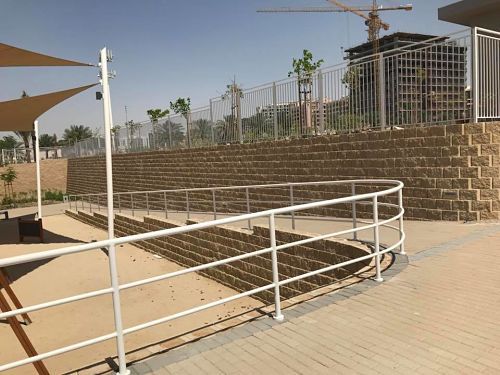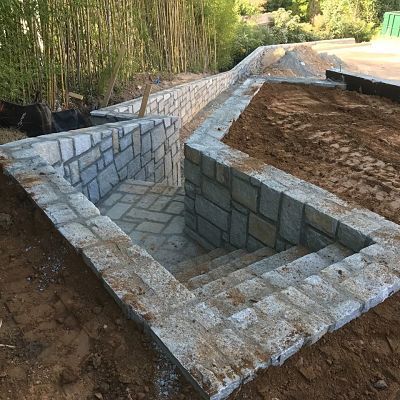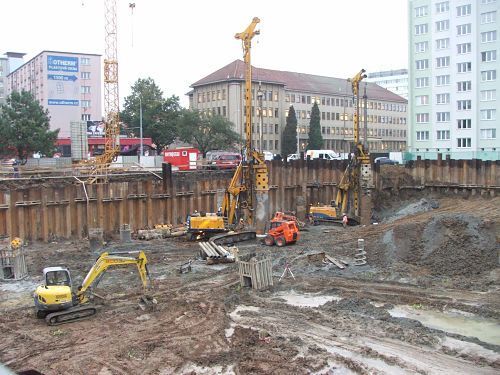What is Retaining Wall?
A retaining wall could be a structure used for maintaining the bottom surfaces at very different elevations on either aspect of it. It provides lateral support to vertical slopes of soil. They keep the soil that might otherwise collapse into an additional form. The preserved soil is brought up as a backfill. It has to be designed to carry the soil back, otherwise, it will tip over or "overturn”. There are many varieties of materials, which will be wont to produce holding walls like concrete blocks, poured concrete, treated timbers, rocks, or boulders. Some are straightforward to use, others have a shorter generation, and however, all will retain soil.

The most common materials used for holding walls are:
- Wood sheets
- Steel and plastic interlocking sheets
- Reinforced concrete sheets –
- Precast concrete parts (crib walls and block walls)
- Closely spaced unaltered soil-cement piles
- Wire-mesh boxes (gabions)
- Anchors into the soil or rock mass (soil nailing)
Types of Retaining Wall
Retaining walls are complete walls that perform as a part of landscaping. Others are elements of building, road, or bridge infrastructure. They are normally created of solid in situ concrete, masonry block walls, or significant timber. Retaining walls classified as either-
Mechanical stable Earth Walls
These walls are among the foremost economical and most typically created. Contrary to different sorts, the MSE walls are supported by the soil and not the opposite means around. The MSE types are:
- Panel Walls
- Concrete Block Walls
- Temporary Earth Walls
Conventional holding walls
It consists of -
- Gravity holding Walls
- Semi-Gravity holding Walls
- Cantilever holding Walls
- Counterfort or braced holding Walls
- Stilt walls
- Miscellaneous
Gravity walls, cantilever walls, and counterfort walls are brought up as rigid holding structures.
Gravity Walls
Gravity walls are the foremost basic strengthened wall that is employed for sheer weight and mass to carry the soil treed. It depends on their self-weight and any soil resting on the concrete in resisting lateral earth forces. Gravity-holding walls encompass the widest quantity of style of building materials; such as as- bricks, pavers, and unmortared stones. It is typically in-built stone masonry, and infrequently in plain concrete. The walls are large and facilitate to contain stability. Gravity walls will be up to 3m (10 feet). within the style of concrete gravity wall, it's essential to work out the masses needed within the stability and stress analyses that are the weight of wall (dead load or helpful force), lateral earth pressure (static and dynamic), surcharge load (live traffic load), earthquake forces (inertia forces), and seismal load (ground motion excitation).

Semi-Gravity Walls
One reasonably specialized gravity wall is thought of as semi-gravity walls. The performance of this kind of wall is to attenuate the breadth of the wall while not requiring large-scale reinforcement. Semi-gravity walls will be manufactured from the gravity and cantilever walls style. The lateral earth pressure is usually withstood by the mass of the wall, similar to within the case of Gravity Walls. Semi- gravity walls are normally used for earth holding structure and bridge abutments infill state of affairs. they will even be employed in a cut state of affairs, except for such Associate in the Nursing application, a brief network is usually needed.
Cantilever Walls
Cantilever walls are created of concrete. The structure consists of a vertical stem, and a base block created from two distinct regions, viz., a heel block, and a toe block. “Stem” acts as a vertical cantilever underneath the lateral earth pressure. Heel slab" acts as a horizontal cantilever underneath the action of the burden of the preserved earth (minus soil pressure acting upwards from below). “Toe slab” acts as a cantilever underneath the action of ensuring soil pressure acting upward. Cantilever holding walls utilize the burden of the soil to carry down a little (foundation or pile) and therefore the stiffness of the affiliation to accomplish a cantilever off the wall. it's the foremost common form of holding structure and is usually economical for heights up to 8m. It resists the horizontal earth pressure furthermore as different vertical pressure utilizing bending of varied parts acting as cantilevers. Perhaps L formed or T formed. Cantilever holding walls are found best up to a height of 6m. For larger heights earth pressure because of preserved fill is going to be higher because of lever arm result, higher moments are created at the bottom, which ends up in the next section for stability style furthermore as structural style. The walls will be formed during an industrial plant or shaped on the website.
Counterfort Retaining walls
It is kind of like Cantilever holding walls except they need skinny vertical concrete webs at regular intervals on the backside of the wall. The counter-forts subdivide the vertical block (stem) into rectangular panels and support them on 2 sides (suspender-style), and themselves behave basically as vertical cantilever beams of T- section and ranging depth. Stem and Heel blocks are reinforced by providing counter-forts at some appropriate intervals. The soundness of the wall is maintained by the burden of the world on the heel block and the self-weight of the structure. For giant heights, during a cantilever wall, the bending moments developed within the stem, heel slab, and toe block becomes terribly massive and needs massive thickness. {adselite}
The bending moments will be considerably reduced by introducing thwartwise supports, referred to as counter-forts. Counter-fort wall is placed at regular intervals of about1/3 to ½ of the wall height, interconnecting the stem with the heel block. The counter-forts square measure hid among the maintained earth on the rear aspect of the wall. This wall is economical for heights higher than (approximately) 7m. This type of wall will be formed or shaped on-site.
Sheet Piles
Piling is an earth retention and excavation support technique that retains soil, victimization sheet sections with interlocking edges. Pile acts as a temporary certificatory wall that has been driven into a slope or excavation to support the collapse of the soft soil from higher ground to lower ground. It provides high resistance to driving stresses and helps to lightweight. Sheet piles will be reused on many comes and .long service life above or below water with modest protection. Simple to adapt the pile length by either attachment or bolting and joints square measure less apt to deform throughout driving.

Usually, sheet piles have two basic types; such as-
- Cantilever sheet pile- Cantilevered sheet piles square measure typically used for the peak of concerning 6m or but dredge line. Cantilever embedded retentive structures square measure specifically used for shielding permanent and temporary excavations, for road constructions, and sanitation of landslides.
- Anchored pile- Anchoring the pile causes less penetration depth and fewer moments to the sheet pile. Anchored walls square measure continually prestressed that basically removes the slacks from the system. The anchor can maintain its load through the excavation sequence unless creep happens. The anchors conjointly place the whole soil mass between the anchors and shut-in compression, so making a very giant gravity well.
Several styles of sheet piles square measure unremarkably employed in construction:
- Wood sheet piles - Wooden sheet piles square measure the oldest construction materials used for temporary light structures to forestall cave-ins. All woods degrade overtimes, particularly once exposed to water and warmth, wherever plants and bugs accelerate decomposition. Wood piling continues to be used today; but, the wood is either absolutely encapsulated, or treated chemically like chrome, aluminum, or steel plating.
- Formed concrete sheet piles- Precast concrete sheet piles square measure a lot of aesthetics however square measure serious and manufacture giant disturbance throughout driving. Concrete sheet piles square measure primarily used as bulkheads in either contemporary or saltwater.
- Steel piles- The steel sheet pile alternative is that the most well-liked because of its strength ease of handling and easy construction. Steel sheet piles square measure on the market in varied cross-sectional shapes. they'll have issues with corrosion that can be prevented by coating. Their thickness is concerning ten to 13mm
- Aluminum sheet piles- Aluminum sheet piles have cross-sections just like those of steel. it is made victimization 6061 alloys, and sometimes anodized, painted, or visible applications. Aluminum is 100% reusable, durable, and immune to corrosion from the air, water, extreme temperature, and chemicals, however, is dearer than different sorts.
Miscellaneous retaining Walls
There square measure different styles of retaining walls. Such as-
Diaphragm walls - Diaphragm wall may be a continuous wall constructed within the ground to facilitate bound construction activities, such as:
- a wall
- a cut-off provision to support deep excavation
- the final wall for basement or different underground structure (e.g. tunnel and shaft)
- a separating structure between major underground facilities
- -a kind of foundation (barrette pile – rectangular pile)
Pile walls (secant piles, tangent piles) - These walls square measure shaped by the intersection of individual concrete piles. These piles square measure designed by victimization lubricator and augering. The secant piles overlap by concerning three inches. Another is that the tangent pile walls, wherever the piles do not have any overlap. These piles square measure made flush with one another. The important advantage of secant and tangent walls is that the exaggerated alignment flexibility. The walls conjointly might have exaggerated stiffness, and therefore the construction method is a smaller amount abuzz. Among the disadvantages square measure that waterproofing is troublesome to get at the joints, their higher price, which vertical tolerances square measure arduous to attain for the deeper piles.
Berliner walls (soldier pile) - This kind of wall was proverbial to Roman military engineers and was used for deep excavations. It is a comparatively cheap system, simple and quick to construct. it is primarily restricted to temporary construction, and can't be employed in high formation conditions while not in-depth dewatering and expense. it is not as stiff as different styles of retentive walls.
Gabion Walls- Gabions square measure multi-celled, welded wire or rectangular wire mesh boxes, that square measure then; rocks crammed, and used for the development of abrasion management structures and stabilize steep slopes. Their applications embody,
- Retaining walls,
- Bridge abutments,
- Wing walls,
- waste pipe headwalls,
- Outlet aprons,
- Shore and beach protection walls, and
- Temporary check dams
Soil nailing walls- Soil nailing may be a technique that will not reinforce and strengthen the existing ground. It consists of putting in closely spaced bars into a slope or excavation as construction income from the highest down. Soil nailing is an efficient and economical methodology of constructing a wall for excavation support, support of hill cuts, bridge abutments, and high ways in which. This method is effective in cohesive soil, broken rock, sedimentary rock, or fixed face conditions. This kind of wall to Stabilization of railroad and road cut slopes and excavation retentive structures in urban areas for high-rise buildings and underground facilities. It is conjointly useful in tunnel portals in steep and unstable stratified slopes. The development and retrofitting of bridge abutments with advanced boundaries involving wall support underneath heaped-up foundations. Soil Nailing through existing concrete or masonry structures like failing retaining walls and bridge abutments to supply long-run stability while not demolition and make prices. Styles of Soil Nailing-
- Driven Nails
- Grouted Nails
- Corrosion Protected Nails
- Jet grouted Nails
- Launched Nails
Crib walls- Individual boxes, made from pre-cast concrete or timber, are interlocked together to create a unit which is called a crib wall. The boxes area unit is then stuffed with crushed stone or alternative coarse granular materials to create a free exhausting structure. Usually, two basic styles of crib wall are found:
- Timber
- Bolstered pre-cast concrete

